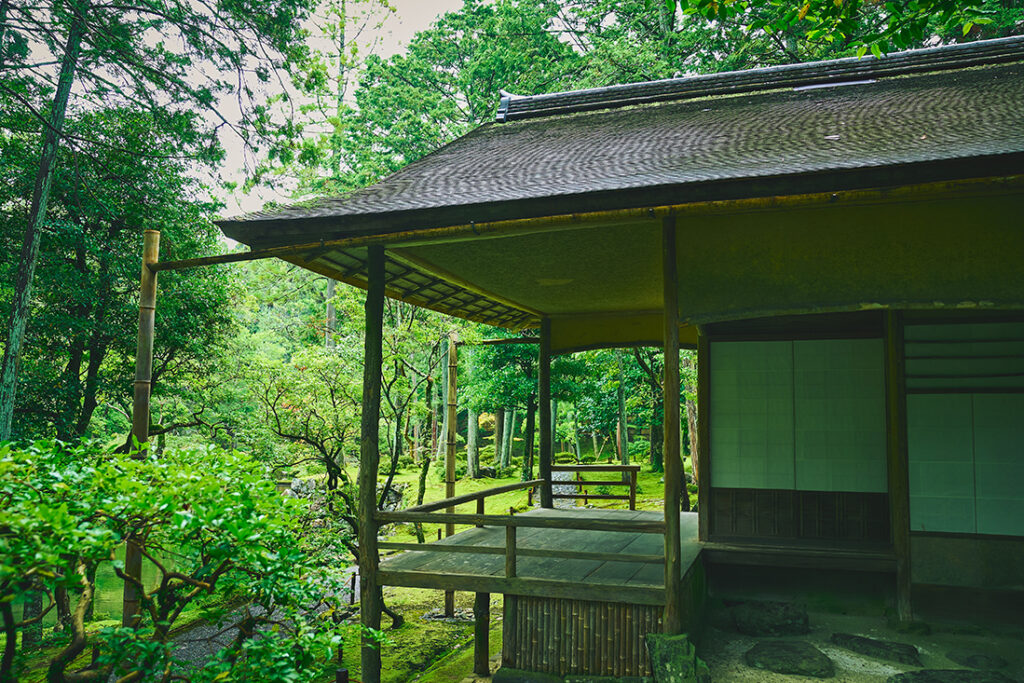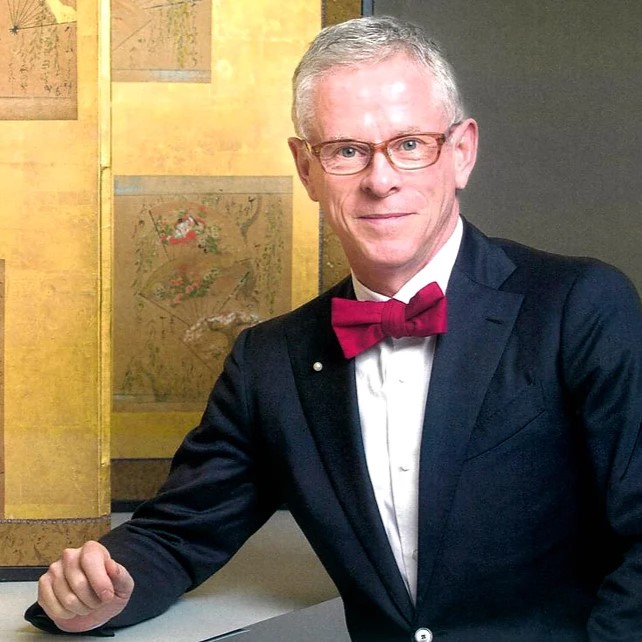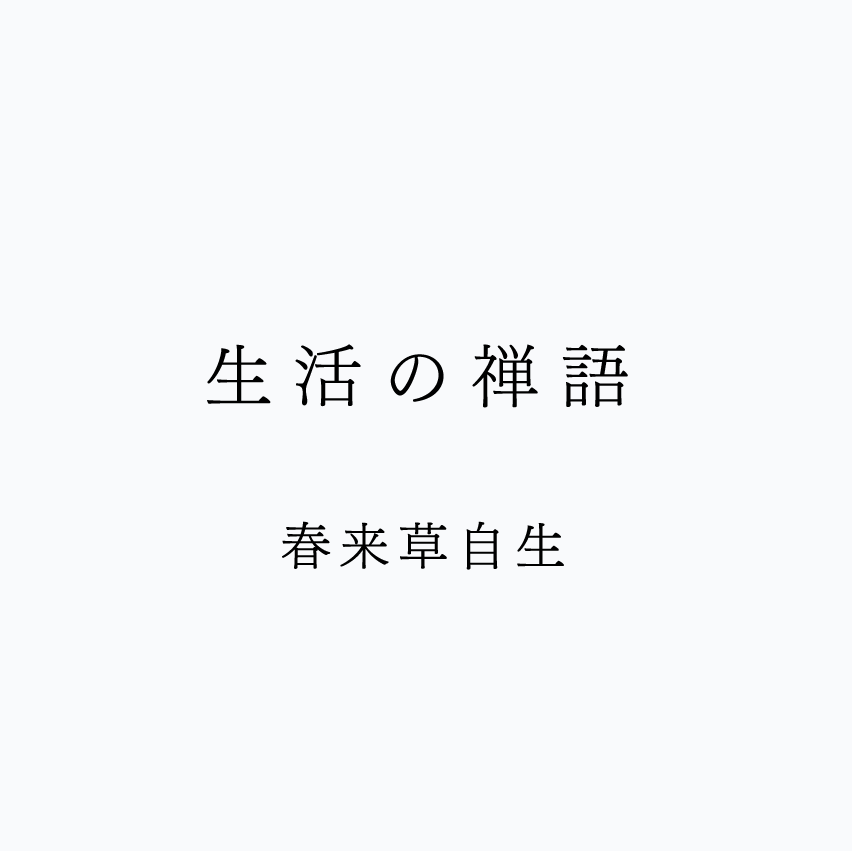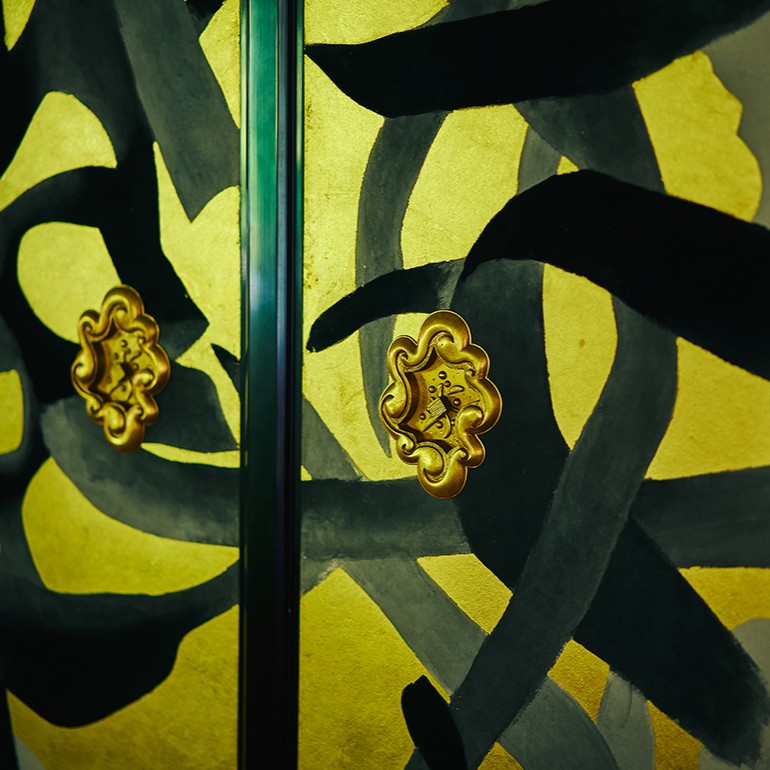2025.10.20
体露金風 西芳寺第十八景
ピーター・J・マクミラン
(翻訳家・詩人)
翻訳者であり詩人でもあるピーター・マクミラン氏が、西芳寺の魅力を綴る「体露金風 西芳寺」シリーズ。日本文化への造詣が深いピーター氏の感性と深い洞察が誘う、心の旅。ぜひ原文の美しい響きも、ご堪能ください。
出逢いは人生一度きり
西芳寺のお庭を歩いていると、湘南亭という有名な茶室の前を通りかかります。湘南亭は、西芳寺に現存する最も古い建物であり、その特徴は月見台を備えていることです。この月見台は興味深いことに、茶室の北側に、池に面して設けられています。つまり夜空の月そのものではなく、水面に映る月を眺めるのに最適な場所なのです。月見台に隣接する部屋が茶室で、その奥には寝室として使用されていた部屋があります。
かつては、この茶室に客人たちが招かれ、茶を楽しみ、月見台から池に映る月を眺めていたのでしょう。湘南亭は約500年前、千利休の養子である千少庵によって建てられたそうですが、利休は豊臣秀吉に切腹を命じられた際、ここに逃げ隠れたと言い伝えられています。その真偽は定かではありませんが、西芳寺を訪れた利休が目に浮かびます。利休は侘び茶を大成したことで知られていますが、禅の精神を茶の湯の中心に据えた人物でもあります。禅寺である西芳寺に、利休はどのような印象を抱いていたのでしょうか。

利休の弟子である山上宗二によると、利休は「一期に一度」というおもてなしの心を基本に茶の湯を説いていました。宗二は著書『山上宗二記』で、「亭主はこの茶会を一生に一度のものと心得て、客人をもてなさなければいけない」と記しています。「一期」の由来は「生まれてから死ぬまで」を意味する仏教用語で、「一度」は文字通り「一度きり」のこと。この言葉は19世紀の中頃、茶の湯に深く傾倒した井伊直弼によって、現代の私たちにも馴染みある「一期一会」という言葉に集約されました。そして一期一会は、茶道のおもてなしの心を表す言葉として知られるようになったのです。
一期一会という言葉は、すべての瞬間が唯一無二であり、二度と訪れないものとして大切にすることの意義を示しています。人生の一瞬一瞬は、すべて一度きりなのです。客人が同じ顔触れであっても、茶道具が同じであっても、世の中は変化しています。そこに集う人々も、前回とはどこか少し違っているはずです。ですから、共に過ごした過去を再現することなど、決してできないのです。
お茶会では、一瞬一瞬が一度きりの経験として扱われています。ですがこれは、客人にできる限り最高のおもてなしを提供しようという亭主の献身的な務めだけでは、体現できません。客人たちも、これ以上ないおもてなしに感謝し、その想いを亭主との会話の中で伝えていく必要があります。亭主と客人の両者が暗黙の了解を心得て、最大の誠意を持って真摯に参加してこそ、お茶会が成功したと言えるのです。
では、一期一会をおもてなしの作法としてだけではなく、生き方の指針として捉えてみてはどうでしょうか。いずれにせよ、二度と戻ってこないというのは、特別な集まりだけではなく、どの瞬間にも言えることです。私たちは客人や亭主という立場にかかわらず、あらゆる人とのすべての出逢いにおいて、どんな瞬間も真摯に向き合うことができるのです。
利休は、西芳寺でどのような日々を過ごしていたのでしょうか。私たちも彼のように、一瞬一瞬を精一杯生きていきたいものです。時にはもてなす側として、時にはもてなされる側として、すべての瞬間に深く貢献し、今この瞬間にしっかりと集中すること。そうすることで、人生一度きりの出逢いを実現してゆけます。一期一会の旅の出発点は、この西芳寺です。そして、お庭を離れる瞬間も、輝きと感動に満ちた日常に戻った後も、旅路は続いてゆくのでしょう。
一期一会については、「生活の禅語」でも紹介しています。こちらからお読みください。
Ichigo Ichie A Lifetime of Once-in-a-Lifetime Encounters
Visitors to the garden of Saihoji almost always pass by the famous tearoom known as the Shonantei Pavillion. It is the oldest building among the extant buildings in Saihoji and boasts a moon-viewing platform. But what is unique about this platform is that it is on the north side of the building near the pond, so best for viewing the reflection of the moon on water, rather than the moon itself. The room adjacent to the moon-viewing platform is a tearoom, and the area beyond is the sleeping quarters.
In the past, guests would have been invited to the tea house to enjoy tea and view the moonlight reflecting on the pond from the moon-viewing platform. The tea house is said to have been built approximately 500 years ago by Sen no Rikyu’s adopted son, Shoan. Sen no Rikyu is one of the most famous tea master’s in Japanese history, and there is a tradition that when Sen no Rikyu was ordered to commit ritual suicide by Toyotomi Hideyoshi, he fled and hid here. The anecdote may be apocryphal, but I like to think of Rikyu coming to Saihoji. Rikyu is famous for completing the wabi style of tea but also for making Zen a central part of tea and as Saihoji is a Zen temple, I wonder what were his impressions of Saihoji.
According to Rikyu’s disciple, Yamanoue Soji, Rikyu advocated a tea based on the term “once in a lifetime” (ichigo ni ichido) hospitality. Based on his master’s teaching, Yamanoue Soji writes in his Yamanoue Sōji Ki that the host should entertain the guest as if the tea ceremony party would only occur once in a lifetime. Ichigo comes from a Buddhist term that means “from one’s birth to one’s death,” and ichido means “once.” Later, in the mid-19th century, Ii Naosuke, the 19th Century Daimyo known for his devotion to tea, restates it as the phrase we know now, “once in a lifetime encounter” (ichigo ichie) which became almost synonymous with tea ceremony hospitality.
Ichigo ichie expresses the importance of treasuring the unique and unrepeatable nature of each moment, for no moment in life is repeatable. The guests may be the same, even the utensils may be the same, but the world will have changed, and each participant will have changed a little since the last gathering, so past gatherings can never be replicated.
Each moment in the tea ceremony is always treated as a once-in-a-lifetime experience. But this is expressed not only in the devotion of the host to providing the best possible hospitality to the guest, but also in the way in which the guests must appreciate the flawless hospitality of the host and express that in their dialogue with the host. The tea ceremony is only successful when both host and guests enter into a kind of unwritten social contract to participate fully and with the utmost sincerity.
What if we think of the ichigo ichie not only as a way of entertaining guests but also as a way of life? After all, not only the moments of special gatherings, but also every moment of our lives passes, never to return. And we can be completely sincere in every moment of every encounter with every person we meet, not just the guests of our parties or the hosts who invite us to parties.
Thinking of the legacy of Sen no Rikyu at Saihoji, let’s vow to live a life where every moment is lived to the full, and where, by turns as host and by turns as guest, we know that the way to have a once in a lifetime encounter is about making a commitment to participate in and be fully present in every moment. The beginning of this ichigo ichie journey is Saihoji, but it will continue also from the moment that we leave the garden and return to the magic and wonders of everyday life.
Peter MacMillan ピーター・J・マクミラン
翻訳家・詩人。株式会社 月の舟(制作・翻訳会社) 代表取締役。
2008年に英訳『百人一首』を出版し、日米で翻訳賞を受賞。2016年9月には英訳『The Tales of Ise』(伊勢物語)、2017年には英訳『One Hundred Poets One Poem Each(新訳)』の2冊がPenguin Booksより出版される。近著に『日本の古典を英語で読む』『英語で味わう万葉集』など著書多数。2019年より朝日新聞にて「星の林に」、2022年より京都新聞にて「不思議の国の和歌ワンダーランド 英語で読む百人一首」を連載。

翻訳:福田安奈






